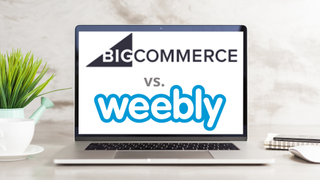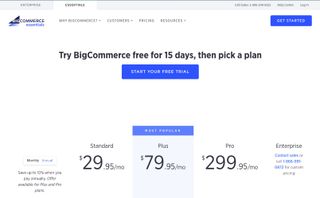BigCommerce vs Weebly: Top choice for SMBs
Two ecommerce website builder giants go head to head

When setting up an online business, much like a physical store, you need to set up your store and house your stuff somewhere. In the language of the web, your storage is called your hosting provider. This is where all your files are kept. Setting up your store is done via website builders, a tool businesses can use to create websites without so much as a background in web development or coding. With drag-and-drop website builders, you can launch your online store in no time.
Together, your hosting provider and your website builder enables your website to run and adds value to your business with core features that will let you have an appealing online store, showcase your products as well as other functionalities of your website that can contribute to a positive user experience while shopping.
To start, you will need a platform that has been made specifically for selling products on the web. In fact, making sure that you choose the right platform is the most crucial step in achieving sales growth - your first and primary goal. In this article, we’ve chosen two of the top ecommerce website builders to help you make the best choice for your SMB, so that you can focus on skyrocketing your sales instead of learning how to code.
BigCommerce and Weebly: Main similarities and differences
Perhaps the most notable difference between one of the two biggest names in ecommerce, BigCommerce and Weebly, is the pricing. Where Weebly is known for its free version that lets users get a feel of it before making a decision, BigCommerce only offers a 15-day free trial. Weebly’s lowest tier is also considerably cheaper at $8 compared to BigCommerce’s basic plan costing $29.95.
On the other hand, both BigCommerce and Weebly are known for their user-friendly website building platforms, and both offer features that freelancers and small and midsize businesses find useful. The two ecommerce giants also have the same high-rated customer support available, which is a crucial factor in deciding which platform to go for.
- Check out our list of the best small business website builders on the market

Pricing
BigCommerce introduces users to three price tiers on their website: Standard, Plus and Pro. The lowest tier offers the cheapest rate, at $29.95 per month. Though, it may be their cheapest offering, this price is pretty high up. Their next tier, Plus, goes for a staggering $79.95 monthly fee, while the highest tier, Pro, costs even more - $299.95 per month.
With four plan tiers, Weebly’s most expensive plan (the Business plan) only costs $25 per month. With prices that range from $0 to $38, it’s an easy win for Weebly. Even their free accounts give free SSL security, 500MB of storage capacity, and a domain albeit with the Weebly branding. Basic and startup businesses will easily turn to Weebly for their website building needs because of its efficiency and budget-friendly plans.
Are you a pro? Subscribe to our newsletter
Sign up to the TechRadar Pro newsletter to get all the top news, opinion, features and guidance your business needs to succeed!
Despite BigCommerce’s 15-day free trial, may feel hesitant to continue with a paid plan granted that the features and services they’re offering are also offered by other website building platforms in the market for a fraction of the price.

Features
BigCommerce is big in complete customization with Page Builder and their intuitive drag-and-drop visual editing tool. They have also partnered with Google, offering industry-standard SEO built into all of the sites they’re hosting. By providing inventory management tools, users can better plan their sales and understand order trends. They also feature 65 payment gateway integrations that make shopping seamless, and social media sales channels that make driving more online traffic possible.
Weebly is big in convenience. Their fully integrated shopping cart, automatically sets itself up upon creating the online store, making checkout secure and done directly from the user’s website. Inventory tracker, filtered product search, and flexible selling options are some of the other features offered by Weebly. They also have a dedicated iPhone and Android app that allows you to manage your store while on your mobile.
Although Weebly provides additional SEO fields that users can easily customize, BigCommerce’s industry standards in SEO triumphs over Weebly in this department. Both do offer Abandoned Cart Saver, an activity dashboard, a CRM, credit card processing, and many other ecommerce required features, so that’s still a plus for Weebly.
Which is best for SMBs?
Businesses looking to launch their online stores for the first time will appreciate Weebly and BigCommerce both being SMB-friendly.
Both allow you to customize your sites with simple drag-and-drop. While this feature is pretty straightforward with Weebly (it’s literally dragging and dropping elements such as text, images, videos, etc.), BigCommerce offers a different approach, allowing you to drag-and-drop blocks that then allow programmers to add widgets for different kinds of product presentation.
With both ensuring attractive storefronts and maximum functionalities, easy-to-set-up navigation features, a CRM or admin panel, and apps or plugins available to make the user shopping experience fast and seamless, both platforms are best for SMBs.
Both also provide reliable community resources for when users are in need of help. The choice to make is between pricing, performance, and where their level of comfort is in going beyond simple customizations.
Ease of use
Their intuitive website builders aren’t the only factors to consider with Weebly and BigCommerce. Account setup, where you begins your journey, is among the most critical. Both offer easy and fast account setup, something you’ll usually find in website builders anyway.
Setting up a Weebly account only takes a couple of steps. It’s as simple as logging on to www.weebly.com, clicking on "Get Started," and dropping your name, email, and creating a password. Once you click on “Sign up,” you can start building your website, and publish it. From here, you can start by selecting a theme, choosing your domain, then design your site to your taste.
After signing up for a BigCommerce account, your dashboard will welcome you. It may be overwhelming to see the dashboard for the first time, but BigCommerce outlines recommended steps from start to publish. Here, you can set up your store profile and add products by category. Next, your payment methods, taxes, shipping methods, shipping rates, and all things backend can be set up. You can then begin the most exciting part - designing your store.
ecommerce
BigCommerce is a powerful ecommerce tool for users who want to attract customers with a stunning website, bring in traffic from multiple channels, scale their business, and essentially grow their brand. This is thanks to features that add value to any online store. These features include POS integrations, Amazon, eBay, and Walmart integration, built-in blog, and so much more.
Weebly makes users showcase their products via their unique online store design and customizable themes. Furthermore, sites with Weebly are optimized by default to help make the websites more discoverable by search engines. Weebly also uses a shipping tool that makes domestic and international shipping easy, as well as an inventory tracker that users can check via their 5-star app anytime and anywhere.
Both platforms offer powerful ecommerce tools that can contribute to the scalability of any small or midsize business. Other additional features from both Weebly and BigCommerce include email marketing, Abandoned Cart Saver, analytics, and more. BigCommerce does have more added perks such as customer touchpoints, product configurator, real-time editing, and a bunch of other features that Weebly fails to offer. BigCommerce takes this showdown by a landslide.
Support
It’s absolutely vital for users to get the support they need whenever and wherever. BigCommerce and Weebly are widely known for the excellent customer service they offer their users. Whether it’s email/help desk (tickets), live chat (24/7), forums, knowledgebase (videos), FAQs, and over the phone, users are likely to get help whenever they need it.
BigCommerce’s training options from webinars, in person, live online, and documentation are the only things giving them an advantage over Weebly. For users who aren’t looking to develop a deeper understanding of how things work, though, a live chat or phone representative walking them through the solution may be enough.
Verdict
For startup businesses whose only concern at the moment is going live albeit with limited functionalities and features, Weebly is the best choice. With Weebly, you can start getting set up without taking any financial risk - their free plan means you won’t be needing to spend any cash if you are on a tight budget.
The significant differences in pricing might make BigCommerce a less viable option for startups or SMBs, but looking into the superiority of their eCommerce features, the customization possibilities on their website builder, and the reliable customer support with multiple channels that are not offered by Weebly, BigCommerce definitely comes out as the strongest in this head to head comparison.
In the end, it’s all just a matter of how much a user is willing to invest in their online store to get the scalability that they desire in less time.
- Don't forget to check out our ecommerce marketing tips this year
Anna is a freelance copywriter with extensive knowledge on the technology sector. She writes about a variety of topics for TechRadar including web hosting, website builders and cybersecurity. She also has a knack for writing deals, guides and versus articles.
Most Popular


